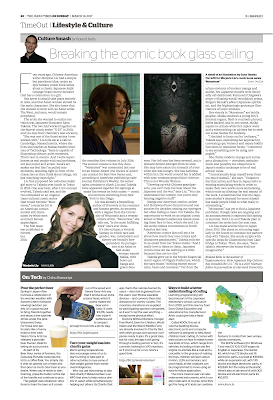The women behind Asian feminist comic "Monstress", for The Japan Times
Breaking the comic book glass ceiling
Four years ago, Chinese-American writer Marjorie Liu had a simple but persistent idea: create an epic fantasy comic book series about a classic Japanese kaijū (strange beast) movie monster that has a connection to a girl.
She knew it should take place entirely in Asia, and that Asian women should be the main characters. She also knew that she wanted to work with an Asian artist. The West, and men, would remain peripheral.
The artist she wanted to realize her vision was Japanese illustrator Sana Takeda. The two had worked together on the Marvel comic series “X-23” in 2010, and Liu says their chemistry was uncanny.
Marjorie Liu
“She was one of the finest artists I ever worked with,” she tells me at a cafe in Cambridge, Massachusetts, where she lives and teaches at Massachusetts Institute of Technology.
“Sana is capable of illustrating silence, quiet moments. That’s rare in comics. And I write superheroes as real people with real problems, not just power and action. Sana’s art makes me feel like I’m pulled into moments, standing right in front of the characters as they think about things, not just watching them fight.”
Sana Takeda
Liu first proposed her nebulous kaijū/girl story to Takeda over lunch in Tokyo in 2013. One year later, after Liu’s concept evolved, Takeda said yes, and the two embarked on an original trans-cultural comic series that would become “Monstress,” a surprise hit in an American comics market still dominated by white men and their female appendages.
The first issue was published in November 2015; the omnibus first volume in July 2016. The second volume is due this June.
“Monstress” was nominated last year for an Eisner Award (the Oscars of American comics) for Best New Series and, according to American publishing trade journal Publisher’s Weekly, the series’ sales continue to climb. Liu and Takeda have appeared together for signings at major fan events on both coasts — comic conventions stretching from New York to San Diego.
Liu was already a best-selling author of 19 novels in the romance and fantasy genres, an attorney with a degree from the University of Wisconsin and a veteran comics writer. “Monstress,” she tells me, “is the most fulfilling work” she’s ever done.
It’s also unique: a visceral fantasy in which race and gender, war, colonialism and slavery are brutally foregrounded. Its protagonist is an Asian or half-Asian woman named Maika, with bowl-cut bangs and green-blue eyes. Her left arm has been severed, and a tentacle demon emerges from its stub. She has darkness within her; the world around her is addled with near-constant geopolitical violence. This is not Wonder Woman.
“Growing up with Chinese grandparents, you can’t help but hear about the Japanese and the war.” says Liu. “You can understand the context, but you’re only hearing negative stuff.”
Manga and American comics, anime and Hollywood have danced around one another for decades, teasing out synergies but often failing to meet. For Takeda, the opportunity to work on an original comic aimed at Western audiences meant meeting them face to face, which she and Liu did at the comics conventions in North America last year.
“American comics fans tell me a lot about how much they love comics and characters passionately,” Takeda tells me in an email from her Tokyo studio. “And I really love to listen to them. Japanese comics fans tell me nothing or a little because they are too shy.”
Takeda grew up in the Myoko Kogen ski resort region of Niigata Prefecture, which she says boasts “nothing except mountains, bears and monkeys.” Far from the urban environs of modern manga and anime, her Japanese models were decidedly old-fashioned: Kuniyoshi Utagawa’s ukiyo-e (floating world) woodblock prints, Shigeru Mizuki’s yōkai (Japanese spirits) art, and the frighteningly grotesque illustrations of Gojin Ishihara.
Her visuals in “Monstress” are boldly graphic. Maika swallows a young boy’s internal organs, flesh is routinely pierced, limbs hacked, and in one scene, Maika squats to urinate while her captor waits and a wisecracking cat advises her to seek out some bushes for modesty.
“I decided to focus on the ‘ordinary,'” Takeda says, explaining her approach to conveying epic violence and messy bodily functions in mundane forms. “I expected to see something new by using new angles.”
She thinks modern manga and anime are a distraction — overdone, melodramatic and possibly too ubiquitous in Japan’s media landscape to be of real artistic value.
“I intentionally keep myself away from too much stimuli,” she says. “I began to feel that artists and fans in Japan refer to existing stimulating works in order to make their own works more stimulating, which ends up diluting the real impact of the work. I sometimes feel that the Japanese market’s demand for more stimuli has made people blind to what really is stimulating.”
“Monstress” has yet to find a Japanese publisher, though talks are ongoing and an announcement is expected this spring or summer. Both Liu and Takeda plan to continue the series into the next year.
Liu has made several trips to Japan since 2012. She plans on returning regularly in the future to continue her partnership with Takeda. She sends scripts with specific ideas for illustrations from Cambridge to Tokyo. Then, she says, “Sana takes it wherever she wants with her imagination.”
Roland Kelts is the author of “Japanamerica: How Japanese Pop Culture has Invaded the U.S.” He is a 2017 Nieman fellow in journalism at Harvard University.






.jpg)